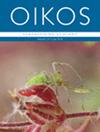鸟类顶级食腐动物的食腐和社会互动受生物区域和季节变化的影响
IF 3
2区 环境科学与生态学
Q2 ECOLOGY
引用次数: 0
摘要
顶端食腐动物可以通过快速清除腐肉来提供重要的生态系统服务,进而调节与尸体分解相关的营养循环。然而,我们对影响顶端食腐动物清除率及其围绕腐肉的行为的生物和非生物因素的了解仍然有限,部分原因是缺乏不同生物区域、栖息地和季节的重复研究。在这里,我们研究了澳大利亚的顶级食腐动物之一--楔尾鹰 Aquila audax 对腐肉的利用,并揭示了它们在腐肉边的社会互动的程度和后果。我们采用标准化设计,在不同的生物区(沙漠、森林和高山)、栖息地(开阔和封闭树冠)和季节(温暖和寒冷)使用相机陷阱监测了 120 只袋鼠(科:袋鼬属)的尸体。我们预测,楔尾鹰在开阔的栖息地会更快地发现尸体,而内在腐肉价值(ICV)或腐肉的可取性将与饮食压力有关,是生产力和季节的函数(即我们预计在生产力较低的沙漠生物区和较凉爽的季节,鹰对尸体的利用会增加)。在所有生物区中,我们发现楔尾鹰在开阔栖息地发现尸体的速度是在封闭栖息地的2.7倍,在凉爽季节发现尸体的速度是在温暖季节的5.3倍。清道夫行为在开放环境中较少发生,在凉爽季节和沙漠生物区更为频繁。ICV在很大程度上决定了社会交往;在凉爽季节和沙漠生物区,楔尾鹰之间的攻击性相遇更多。我们的研究结果突显了生物区系、栖息地和季节性变化如何驱动同种顶级食腐动物之间的食腐率和社会互动。进一步的研究将考虑腐肉的使用和相应的行为互动,这将加深我们对腐肉如何在物种群之间、物种群内部以及更广泛的食腐动物群落中形成互动关系的理解。本文章由计算机程序翻译,如有差异,请以英文原文为准。
Scavenging and social interaction of an apex avian scavenger is governed by bioregional and seasonal variation
Apex scavengers can perform an important ecosystem service by rapidly removing carrion, in turn regulating nutrient cycling linked to carcass decomposition. Yet, our understanding of the biotic and abiotic factors that influence rates of apex scavenging and their behaviour around carrion remains limited, in part because of the absence of replicated studies across different bioregions, habitats and seasons. Here, we examine the use of carrion by one of Australia's apex scavengers, the wedge‐tailed eagle Aquila audax , and uncover the extent and consequences of their social interactions at carrion. We applied a standardised design to monitor 120 kangaroo (Family: Macropodidae) carcasses using camera traps across contrasting bioregions (desert, forest and alpine), habitats (open and closed canopy) and seasons (warm and cool). We predicted that wedge‐tailed eagles would discover carcasses quicker in open habitats, and that intrinsic carrion value (ICV), or the desirability of carrion, would be related to dietary stress as a function of productivity and season (i.e. we expected to see increased carcass use by eagles in the less productive desert bioregion and in cooler seasons). Across all bioregions, we found that wedge‐tailed eagles discovered carcasses in open habitats 2.7 times faster than in closed habitats and 5.3 times faster in cool seasons compared with warm seasons. Scavenging was less likely to occur in open environments, was more frequent in cool seasons and in the desert bioregion. ICV largely governed social interactions; there were more aggressive encounters between wedge‐tailed eagles during cool seasons and in the desert bioregion. Our results highlight how bioregional, habitat, and seasonal variation can drive scavenging rates and social interactions between conspecific apex scavengers. Further studies considering both carrion use and corresponding behavioural interactions will enhance our understanding of how carrion contributes to shaping interactions between and within species groups as well as scavenger communities more broadly.
求助全文
通过发布文献求助,成功后即可免费获取论文全文。
去求助
来源期刊

Oikos
环境科学-生态学
CiteScore
6.20
自引率
5.90%
发文量
152
审稿时长
6-12 weeks
期刊介绍:
Oikos publishes original and innovative research on all aspects of ecology, defined as organism-environment interactions at various spatiotemporal scales, so including macroecology and evolutionary ecology. Emphasis is on theoretical and empirical work aimed at generalization and synthesis across taxa, systems and ecological disciplines. Papers can contribute to new developments in ecology by reporting novel theory or critical empirical results, and "synthesis" can include developing new theory, tests of general hypotheses, or bringing together established or emerging areas of ecology. Confirming or extending the established literature, by for example showing results that are novel for a new taxon, or purely applied research, is given low priority.
 求助内容:
求助内容: 应助结果提醒方式:
应助结果提醒方式:


